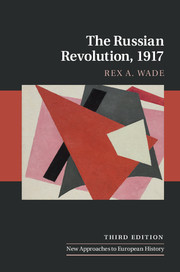Book contents
- The Russian Revolution, 1917
- New Approaches to European History
- The Russian Revolution, 1917
- Copyright page
- Contents
- Plates
- Maps
- Preface
- Chronology
- 1 The coming of the revolution
- 2 The February Revolution
- 3 Political realignment and the new political system
- 4 The aspirations of Russian society
- 5 The peasants and the purposes of revolution
- 6 The nationalities: identity and opportunity
- 7 The summer of discontents
- 8 “All Power to the Soviets”
- 9 The Bolsheviks take power
- 10 The Constituent Assembly and the purposes of power
- 11 Conclusions
- Notes
- Further reading
- Index
- New Approaches to European History
- References
Further reading
Published online by Cambridge University Press: 02 February 2017
- The Russian Revolution, 1917
- New Approaches to European History
- The Russian Revolution, 1917
- Copyright page
- Contents
- Plates
- Maps
- Preface
- Chronology
- 1 The coming of the revolution
- 2 The February Revolution
- 3 Political realignment and the new political system
- 4 The aspirations of Russian society
- 5 The peasants and the purposes of revolution
- 6 The nationalities: identity and opportunity
- 7 The summer of discontents
- 8 “All Power to the Soviets”
- 9 The Bolsheviks take power
- 10 The Constituent Assembly and the purposes of power
- 11 Conclusions
- Notes
- Further reading
- Index
- New Approaches to European History
- References
- Type
- Chapter
- Information
- The Russian Revolution, 1917 , pp. 320 - 338Publisher: Cambridge University PressPrint publication year: 2017
References
Further reading
The following gives an extensive list of further reading. Only English-language works are included, as explained in the preface. Special attention should be drawn to several books that contain large number of articles on 1917 which are not listed separately but which contribute important essays on the revolution. Especially valuable are the collection edited by Robert Service and that edited by Frankel, Frankel, and Knei-Paz. Special note should also be taken of the many short essays in Critical Companion to the Russian Revolution as well as two earlier encyclopedias of the revolution edited by Harold Shukman and by George Jackson and Robert Devlin. Somewhat older but with still valuable essays are the collections edited by Elwood and Pipes. Most recent are the volumes being published in the Russia's Great War and Revolution project, three initial sets of which have been published and are listed below under volume titles (Russia's Home Front in War and Revolution, Russian Culture in War and Revolution, The Empire and Nationalism at War), with more forthcoming. All these works contain a wealth of material which should not be overlooked by the interested reader just because the many essays cannot be listed separately. Some of them are cited in the endnotes. Extensive bibliographies on the revolutionary era are those of Murray Frame and Jonathan Smele.

